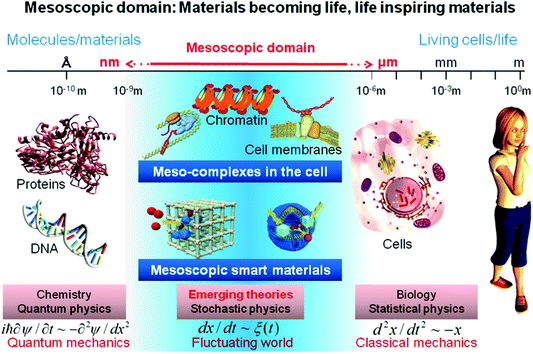Mesoscopic science, where materials become life and life inspires materials. A great opportunity to push back the frontiers of life, materials, and biomaterials sciences
Norio Nakatsuji
Among the first things you see when you visit the RSC Biomaterials Science website will be the journal's scope, which reads:Biomaterials Science is an international, high impact journal bringing together the molecular and mesoscopic interactions of biomaterials and their potential applications. The journal is a collaborative venture between RSC Publishing and the Institute for Integrated Cell-Material Sciences, Kyoto University, Japan.
The word, “mesoscopic,” may be quite new for those from the biological background. If your scientific base is physics, however, you may know it from “mesoscopic physics,” which indicates physics on the scale between nanometers and micrometers where quantum phenomena appear to interfere with macroscopic, statistical physics principles. For a detailed examination of the mesoscopic realm, see Mark Haw's Middle World: The Restless Heart of Matter and Life (Palgrave Macmillan, 2006).
At Kyoto University, when our new Institute for Integrated Cell-Material Sciences (WPI-iCeMS) was founded in 2007, we started focusing our attention on this mesoscopic domain in biological systems of living cells, in addition to the rapidly progressing materials science field of dynamic and functional smart materials. For more information, please visit our website at http://www.icems.kyoto-u.ac.jp.
Mesoscopic/mesoscale science is receiving growing attention, notably since 2011 when the US Department of Energy (DOE) started discussing and exploring the potential of mesoscale science and technology at its Basic Energy Sciences Advisory Committee (BESAC: science.energy.gov/bes/besac/) meetings as well at big conferences, such as the February 2012 American Physical Society meeting in Boston and the March 2012 American Chemical Society meeting in San Diego. The series of the Department's actions have attracted news coverage in scientific journals, including “The next big(ger) thing” (Science, 2012, 335, 1167) and “Mesoscale physics buzz eludes exact definition” (Nature News Blog, 1 March 2012).
Between the nanoscopic (the realm of atoms and simple molecules up to several nm in size) and the macroscopic (our everyday world, consisting of everything larger than 1 μm, thus sometimes called microscopic) lies the mesoscopic domain: a scale dominated by interactions among large molecules inside or outside living cells.
Cells are, in essence, living factories of enzymes and molecules. Understanding these processes and ultimately learning to control or mimic them would promise to lead to breakthroughs in next generation medicine, functional smart materials, and green chemical technologies. Harnessing the power of cells, mastering mesoscopic space, is the key to solving many of the technological crises facing humanity today.
Living cells have evolved the tools for mesoscopic control through natural selection: tools which a solid and less flexible mechanism would have to expend vast quantities of resources in order to wield. Yet cells are able to complete their multitude of functions, performing their chemistry cleanly and precisely, in water solutions and at standard temperatures and pressures, all while continuously adapting to outside conditions. Also, all cellular functions, from extremely efficient energy conversion in photosynthesis to the control of cell proliferation and differentiation, result from the cumulative, ceaseless, and often error-prone movements of countless molecules inside and outside the cell.
These mesoscopic investigations of living cells can be integrated with rapidly developing fields of functional smart materials to create multidisciplinary mesoscopic sciences. Such studies may well include: (1) imaging and probing of mesoscopic complexes in living cells, (2) production of functional mesoscopic materials, and (3) integration of mesoscopic materials and living cells, so as to achieve breakthroughs in biomaterials science and biotechnology.
In brief, the mesoscopic domain exists between the nano-space and the bulk space, and is larger than micrometers. In the cellular mesoscopic domain, various biopolymers are in constant motion, while forming multi-molecular architectures such as the cell membrane and other organelle structures, still robustly executing intricate cellular functions. In the material world, the mesoscopic domain consists of a complicated, dynamic, multi-component domain based upon, and obtaining a higher functionality from, the nanoscopic domain made of a predictable and relatively small number of atoms and molecules.
So far, research into functional materials has usually favoured the bulk scale. However, recent studies have led to the development of soft-crystalline particles and functional architectures in the mesoscale. Individual molecules at the nano-level, as well as solids larger than one micron, both tend to have singular, clearly defined functions. Mesoscopic materials, in contrast, are able to adapt smart functions for desired purposes, creating flexible and reciprocal relationships that are inspired by the fluctuating architectures inside living cells. An ability to freely design, build, and employ functional mesoscopic materials will lead to unprecedented technologies in biomaterials science with applications in the control of living cells and systems, including human bodies.
| This journal is © The Royal Society of Chemistry 2013 |



